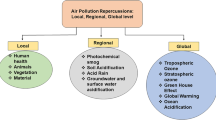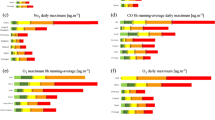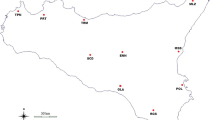Abstract
The so-called Air Quality Index (AQI), expresses the quality of atmospheric air. The overall AQI is determined from the AQIs of some reference air pollutants, which are calculated by a transform of the respective concentrations. Concentrations of air pollutants are compositional data; they are expressed as part of mass of each pollutant in a total air volume or mass. Therefore, air pollution concentration data, as compositional data, just provide ratio information between concentrations of pollutants. Operations involved in the computation of overall AQI are not admissible operations in the framework of compositional data analysis, as they destroy the original ratio information. Consequently, the standard methodology should be reviewed for such calculations, taking into account the principles and operations of compositional data analysis. The objective of this article is to present a first approach to incorporate compositional perspective to air quality expression. For this, it is proposed to use a balance log-contrast of concentrations expressed in \(\upmu \)g/m\(^3\) to define a new kind of air quality indicator. Furthermore, the geometric mean of the concentrations is applied to obtain a new and simple scale air quality index, avoiding definition of piecewise linear interpolations used in the standard AQI computation. As an illustrative example, statistical analysis of atmospheric pollution data series (2004–2013) of the city of Madrid (Spain) has been carried out.






Similar content being viewed by others
References
Aitchison J (1986) The statistical analysis of compositional data. Monographs on statistics and applied probability. Chapman & Hall Ltd., London
Aitchison J, Egozcue JJ (2005) Compositional data analysis: where are we and where should we be heading? Math Geol 37(7):829–850
Bishoi B, Prakash A, Jain V (2009) A comparative study of air quality index based on factor analysis and US-EPA methods for an urban environment. Aerosol Air Qual Res 9:1–17
Bruno F, Cocchi D (2002) A unified strategy for building simple air quality indices. Environmetrics 13:243–261
Egozcue JJ (2009) Reply to “On the Harker variation diagrams;..” by J. A. Cortés. Math Geosci 41(7):829–834
Egozcue JJ, Jarauta-Bragulat E (2014) Differential models for evolutionary compositions. Math Geosci 46(4):381–410
Egozcue JJ, Pawlowsky-Glahn V (2005) Groups of parts and their balances in compositional data analysis. Math Geol 37(7):795–828
Egozcue JJ, Pawlowsky-Glahn V (2011a) Análisis composicional de datos en ciencias geoambientales. Boletín Geológico y Minero 122(4):439–452
Egozcue JJ, Pawlowsky-Glahn V (2011b) Basic concepts and procedures. In: Pawlowsky-Glahn V, Buccianti A (eds) Compositional data analysis. Theory and applications. Wiley, New York
Pearson K (1897) Mathematical contributions to the theory of evolution on a form of spurious correlation which may arise when indices are used in the measurement of organs. In: Proceedings of the Royal Society of London LX, pp 489–502
Plaia A, Di Salvo F, Ruggieri M, Agró G (2013) A multisite-multipollutant air quality index. Atmos Environ 70:387–391
Plaia A, Ruggieri M (2011) Air quality indices: a review. Rev Environ Sci Biotechnol 10:165–179
Russo A, Soares A (2014) Hybrid model for urban air pollution forecasting: a stochastic spatio-temporal approach. Math Geosci 46:75–93
The World Bank (2013) Report. on line. data.worldbank.org/indicator/SP.URB.TOTL.IN.ZS
van den Elshout S, Léger K, Nussio F (2008) Comparing urban air quality in europe in real time. A review of existing air quality indices and the proposal of a common alternative. DCMR Environ Int 34:720–726
Acknowledgments
This work has been supported by the Ministerio de Economía y Competitividad of Spain under projects ENE2012-36871-C02-01, partially funded by the European Union, and METRICS Ref. MTM2012-33236; and within the framework of Consolidated Research Group of the Generalitat de Catalunya (Spain) AGAUR 2014-SGR-551. Authors also are thankful to Ayuntamiento de Madrid (Spain) for granting air pollution data.
Author information
Authors and Affiliations
Corresponding author
Rights and permissions
About this article
Cite this article
Jarauta-Bragulat, E., Hervada-Sala, C. & Egozcue, J.J. Air Quality Index Revisited from a Compositional Point of View. Math Geosci 48, 581–593 (2016). https://doi.org/10.1007/s11004-015-9599-5
Received:
Accepted:
Published:
Issue Date:
DOI: https://doi.org/10.1007/s11004-015-9599-5




